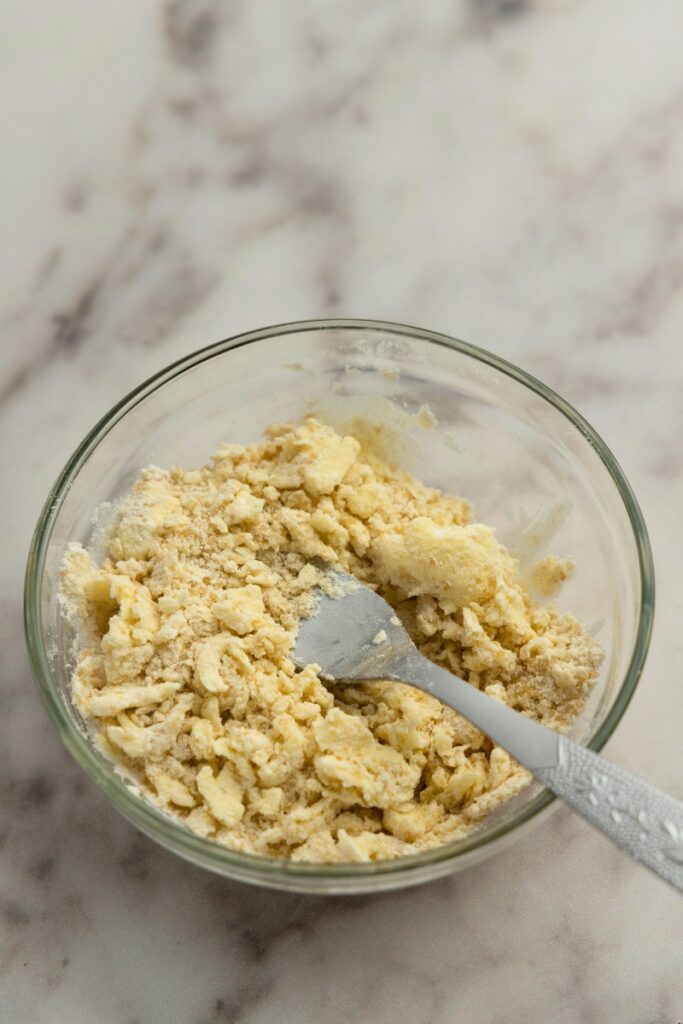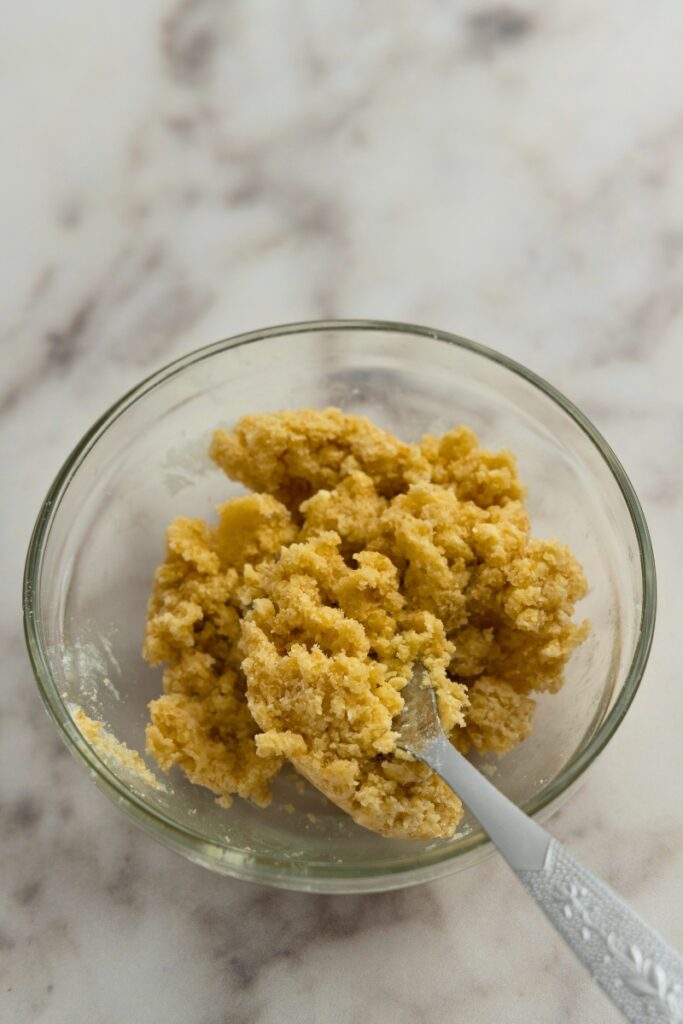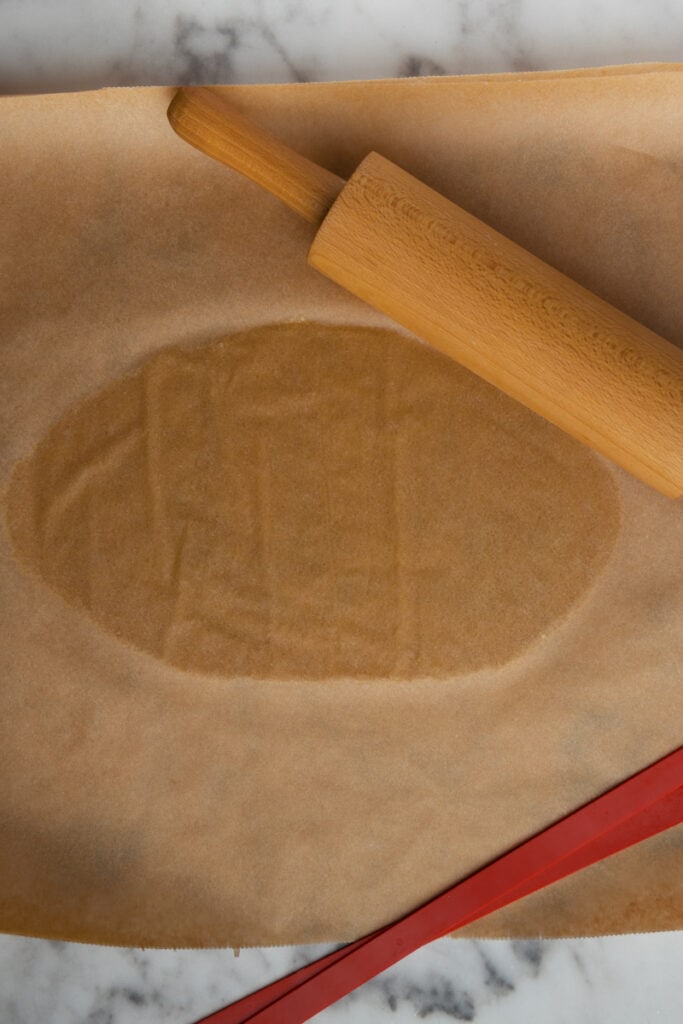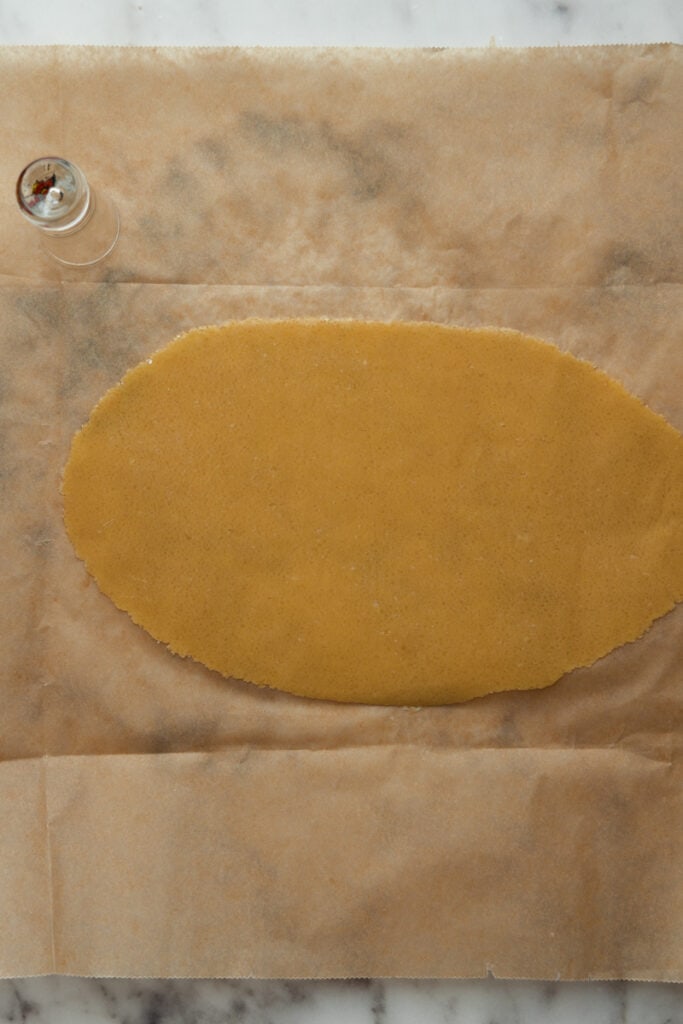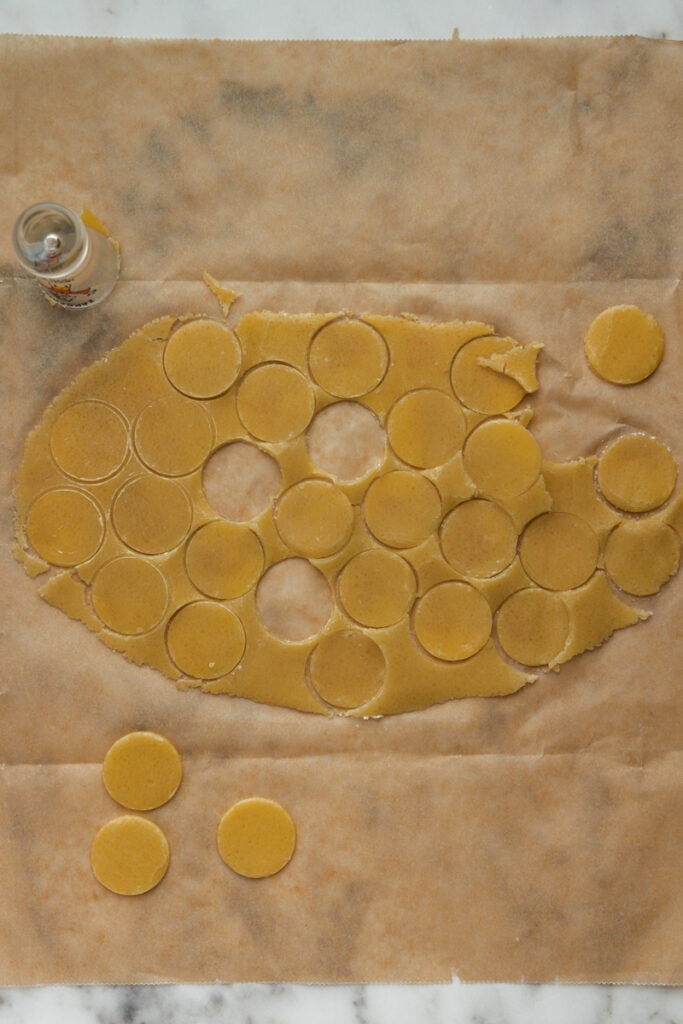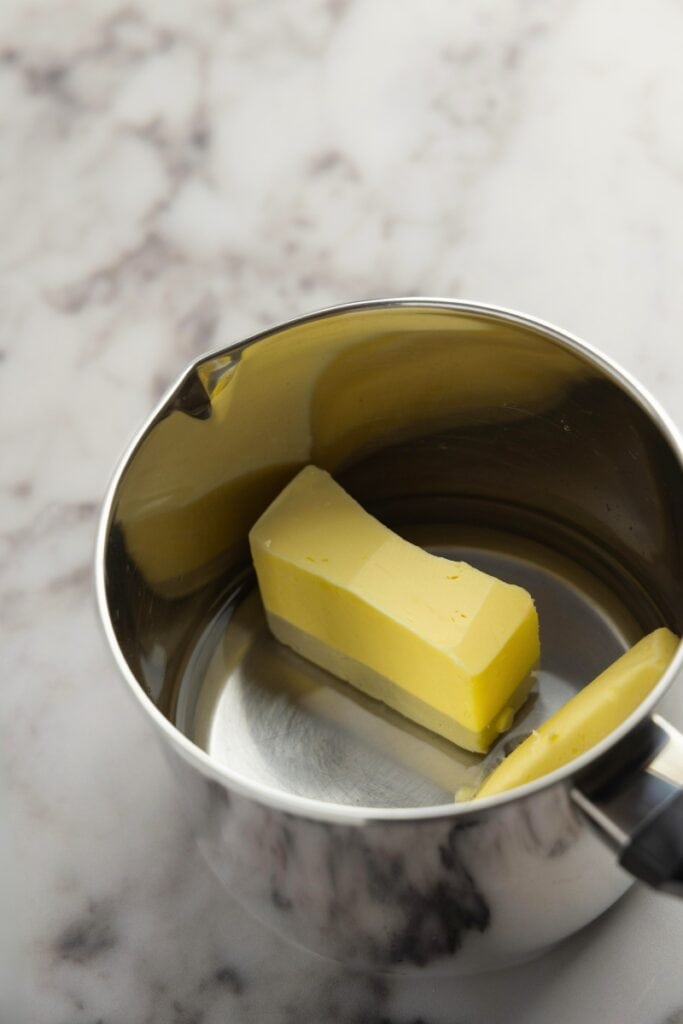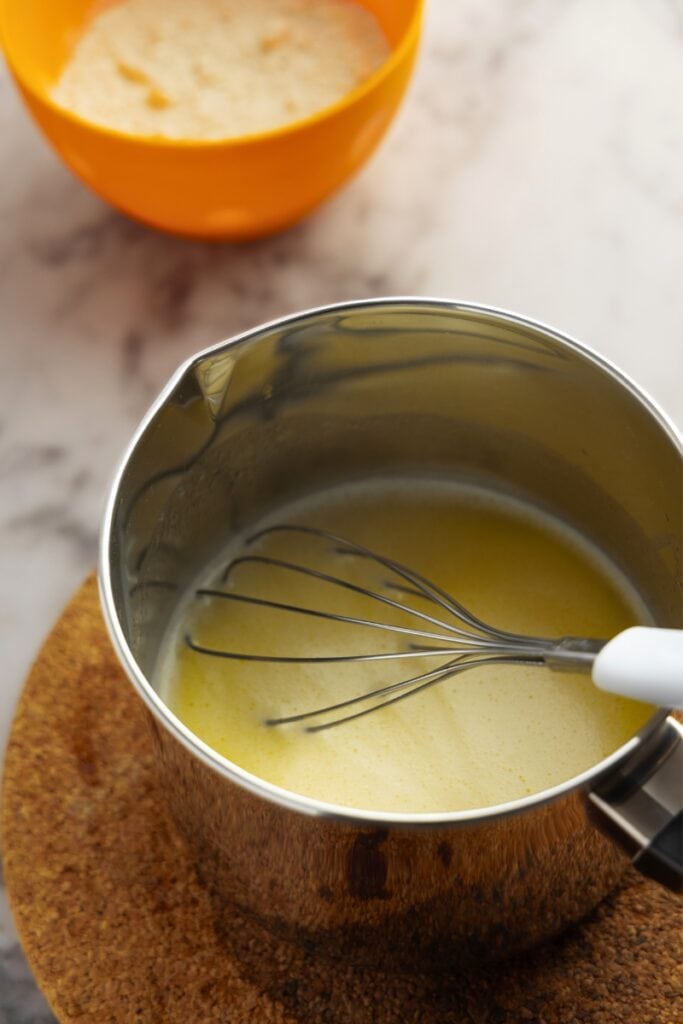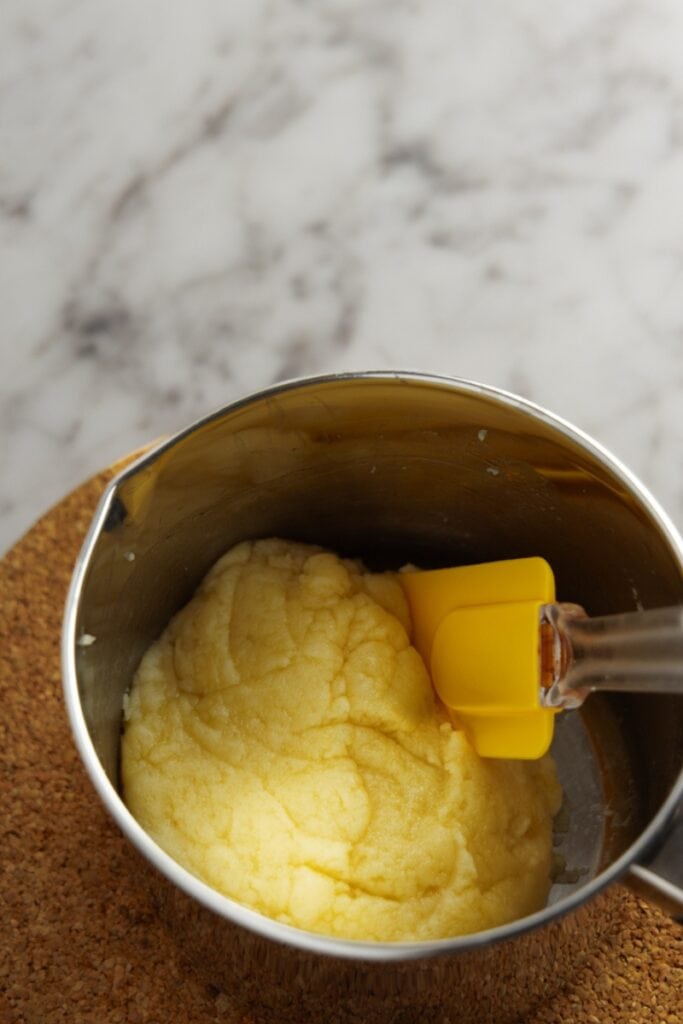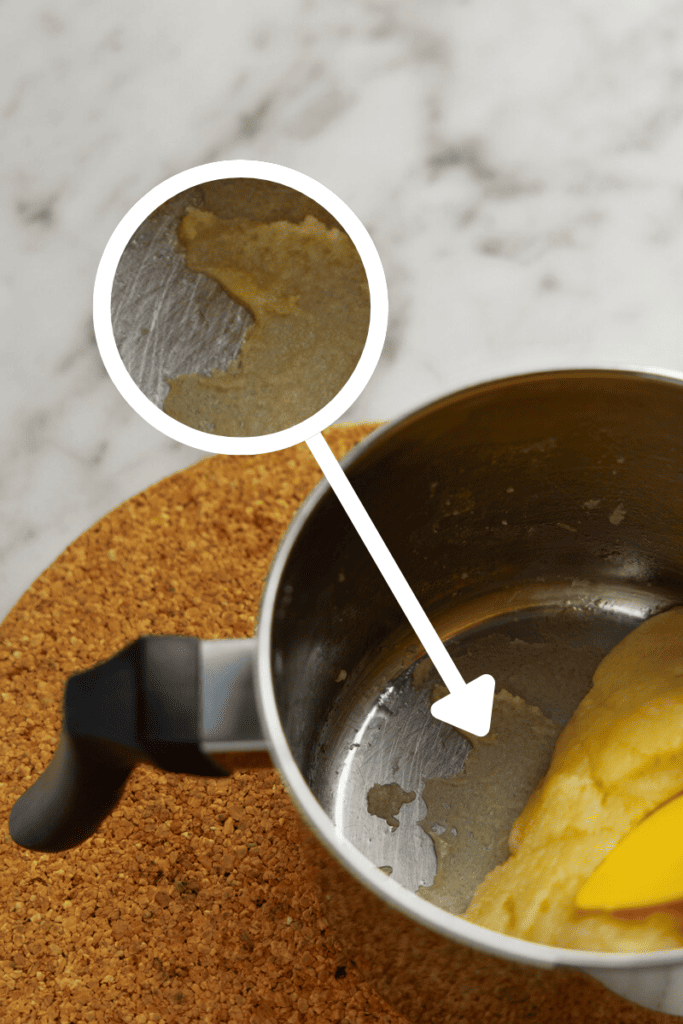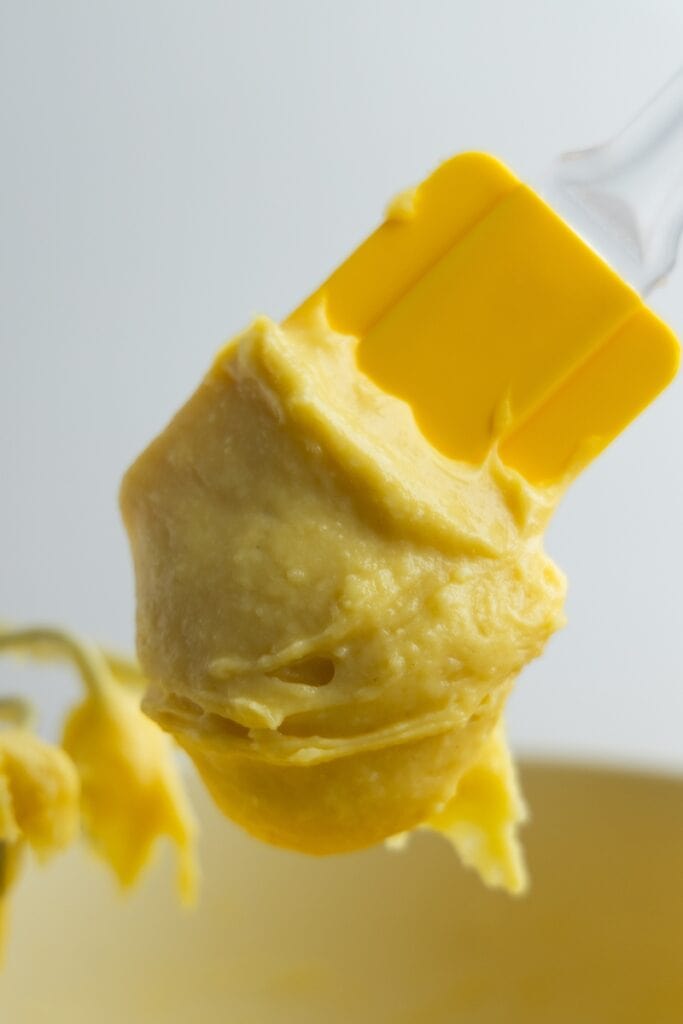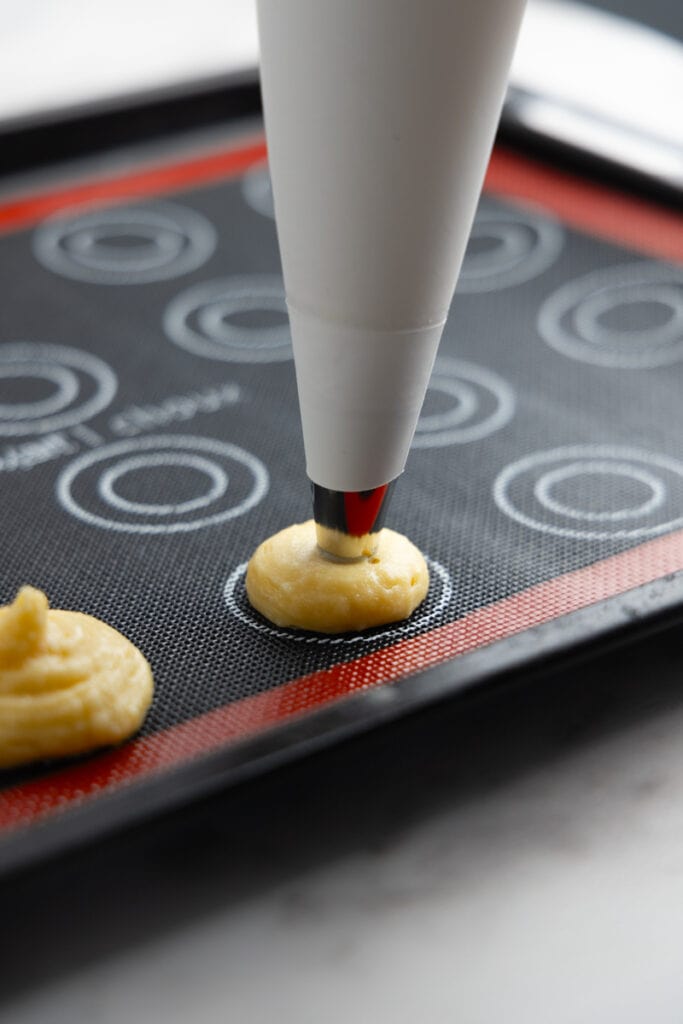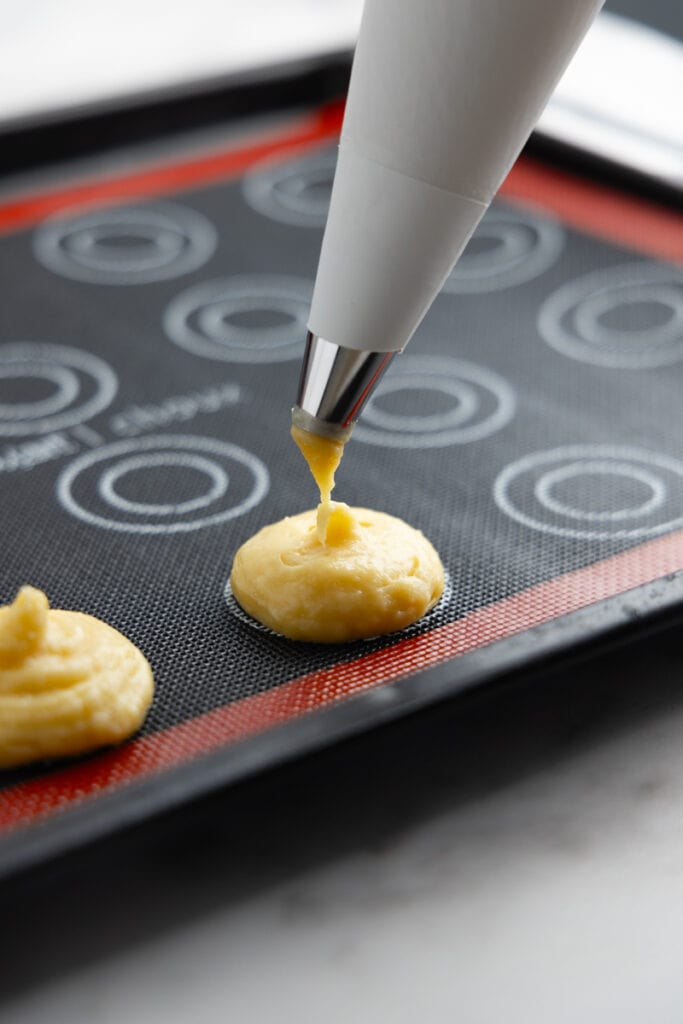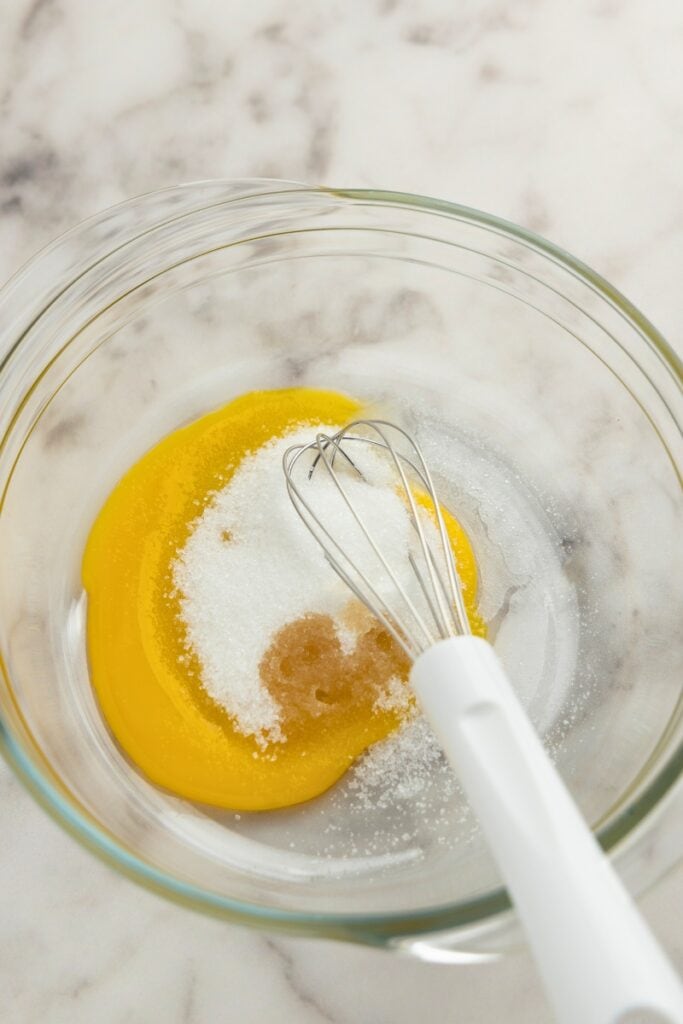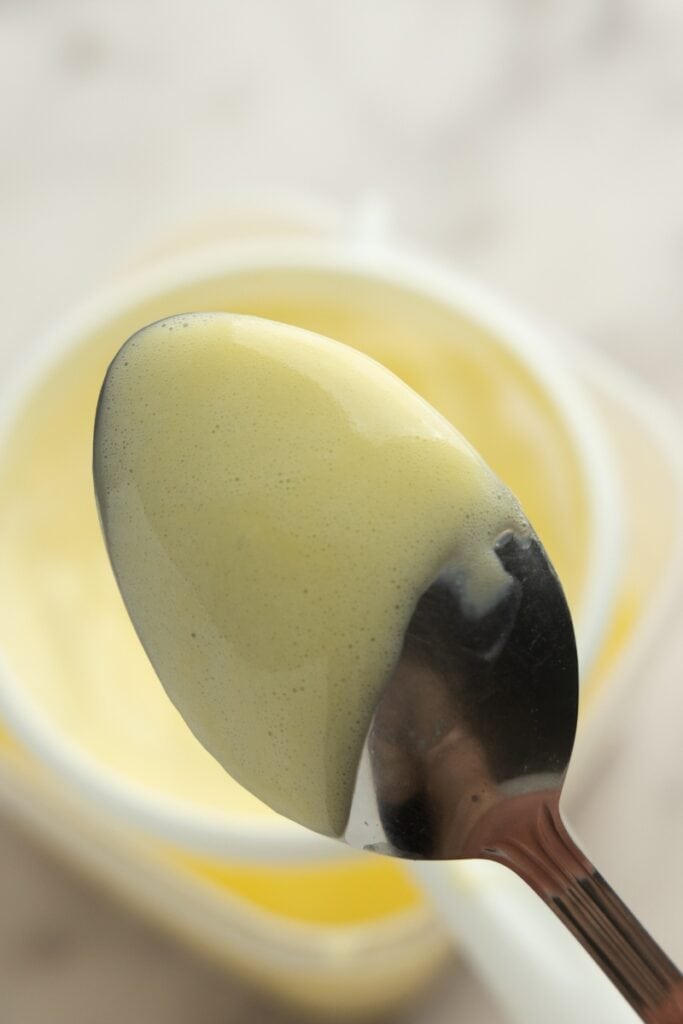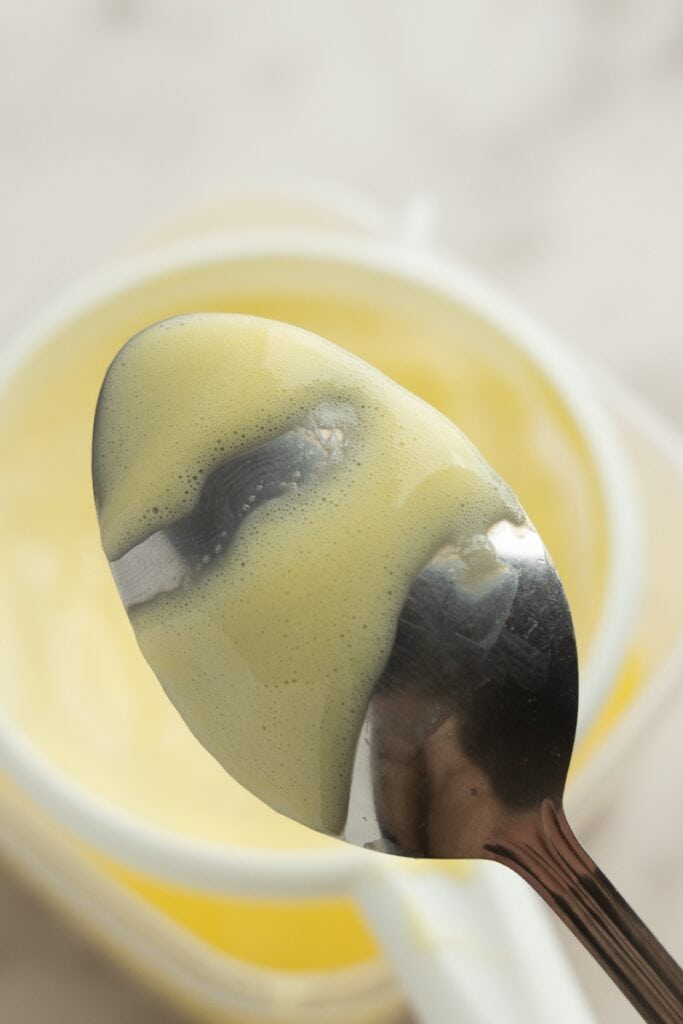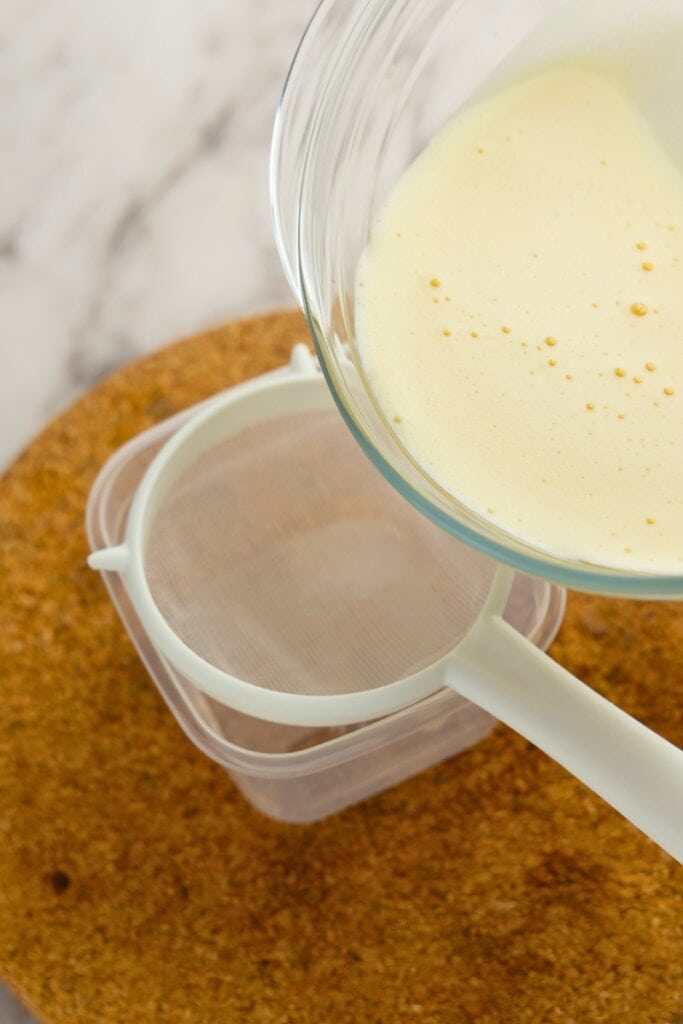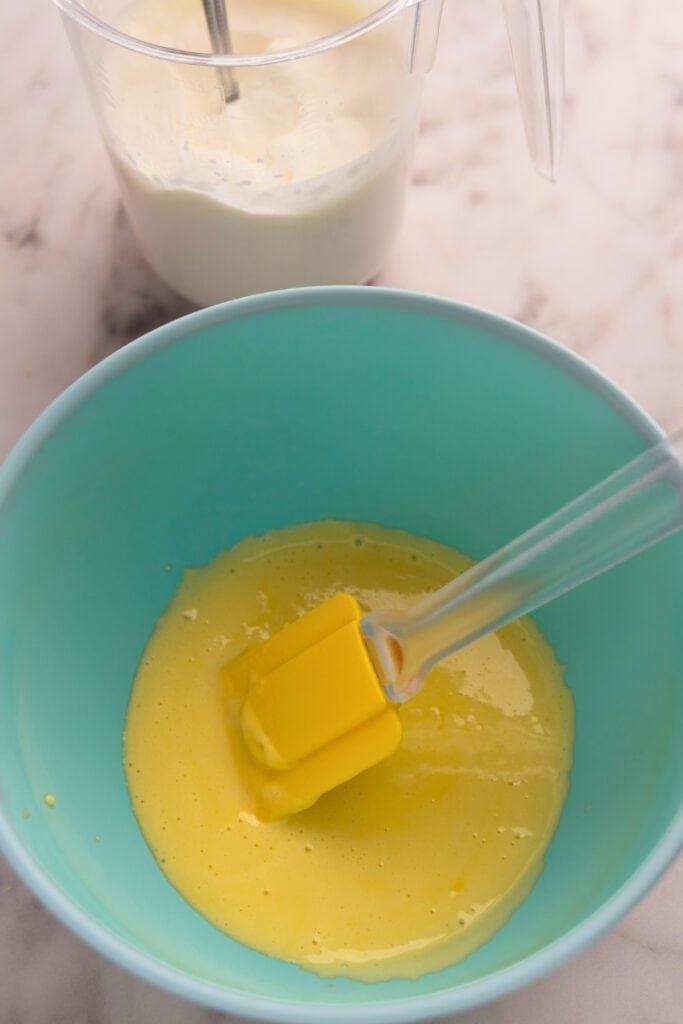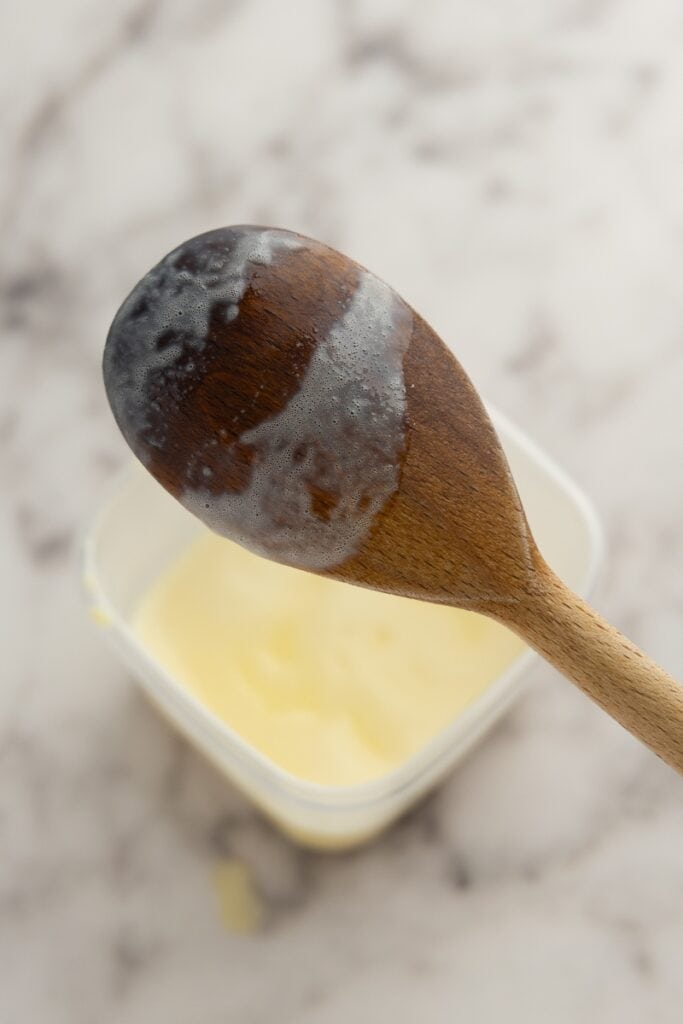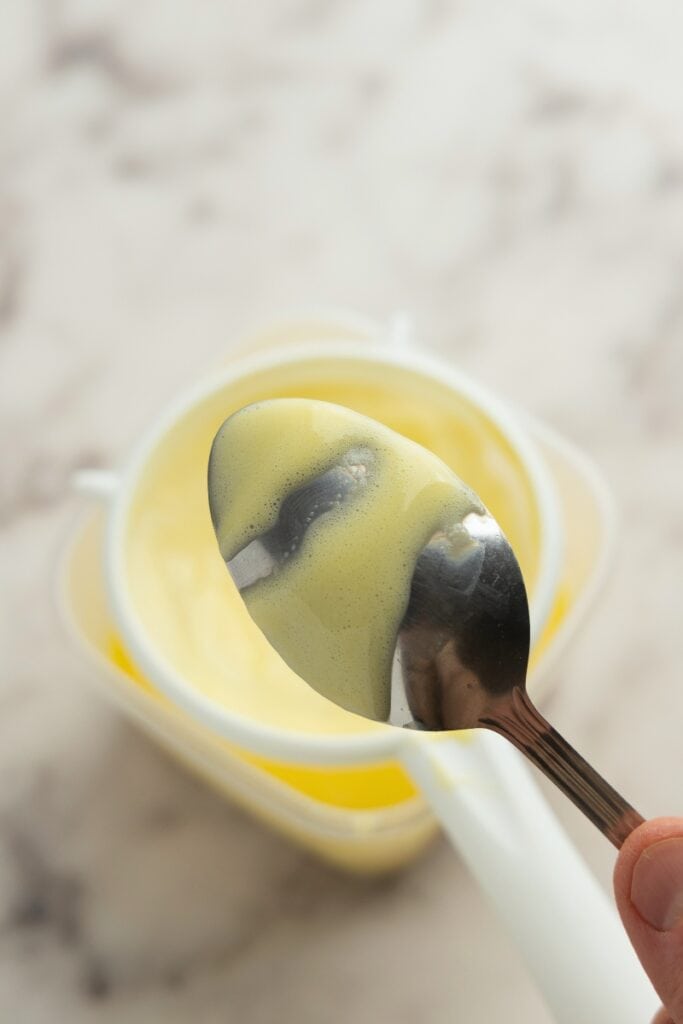Bavarian Cream Puffs
This post may contain affiliate links. Read our privacy policy.
These Bavarian cream puffs are a fantastic twist on the classic, offering a lighter texture and irresistible flavor. Let’s walk through the steps together to create something special!
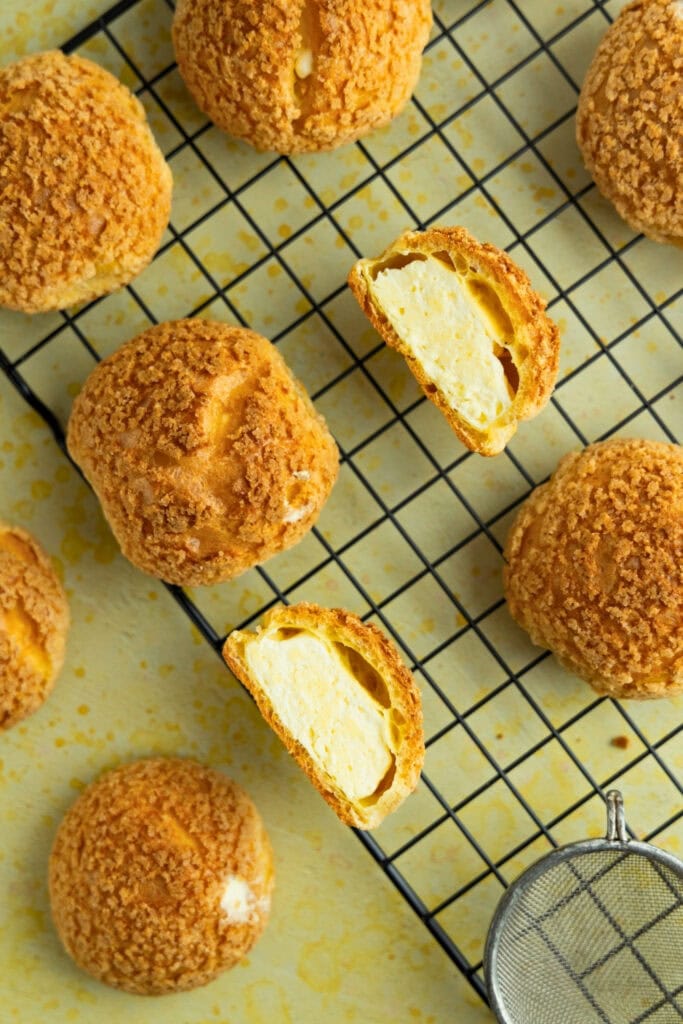
Recipe At a Glance
Bavarian cream puffs offer a delightful twist on traditional cream puffs, featuring a similar taste but a lighter texture compared to vanilla cream puffs. These are also quite similar to our Choux au Craquelin recipe because of the crumb topping.
Here’s our game plan:
First, we’ll prepare the crumb topping. Next, we’ll tackle the choux pastry, pipe out the puffs, and top them with the crumb topping we prepared earlier.
While the puffs are baking, we’ll cook the creme anglaise, blend in some gelatin, and let it cool. During this time, we’ll also whip up a generous amount of heavy cream.
After the creme anglaise has cooled, we’ll gently fold in the whipped cream to create a luscious Bavarian cream (or creme bavaroise).
The final steps involve filling the puffs with the cream and chilling them in the refrigerator to set the filling.
(Not familiar with some of these terms? No worries, I’ll guide you through each step.)
If you’re new to this, be sure to read the ingredient notes, detailed instructions, and helpful tips provided. If you’re familiar with the process, you can jump straight to the recipe card.

Ingredient Notes and Substitutes
Cream Puffs
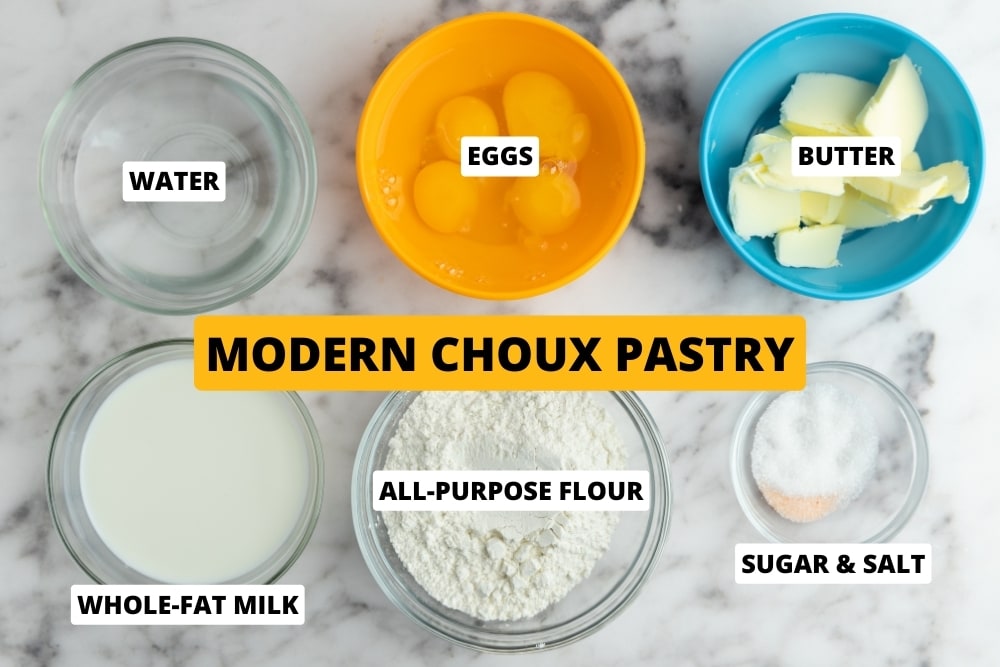
- Water and milk. Full-fat milk works best, but skim should work in a pinch. I wouldn’t experiment with vegan milk, as it might alter the flavor of the choux. It’s better to use just water instead.
- All-purpose flour.
- Unsalted butter.
- Eggs.
- Salt and sugar. Sugar alternatives are perfectly fine.
Crumb Topping

- Unsalted butter.
- All-purpose flour.
- Brown sugar. White sugar is also fine; just make sure it’s in crystal form and not powdered.
Bavarian Cream
- Milk: Regular full-fat milk works great, but you can opt for half and half or go with half heavy cream half milk if you’d like the bavaroise to be richer.
- Egg yolks: Egg yolks thicken the custard.
- Sugar: Regular table sugar is all you need.
- Vanilla extract: Our source of vanilla flavor. If using vanilla beans, infuse them into the milk as I described in my recipe for crème patisserie.
- Gelatin: Gelatin helps the crème anglaise and whipped cream mixture thicken and set after chilling. Powdered gelatin is readily available and easy to use, but if you prefer gelatin leaves, ensure you adjust the quantity needed.
- Heavy Cream: Go with whatever brand you use for whipping.
How to Make Bavarian Cream Puffs
Here’s a quick overview:
- Start by preparing the crumb topping and the choux pastry, then bake the puffs.
- While the puffs bake, we’ll cook the creme anglaise, add gelatin, and let it cool. Meanwhile, we whip the heavy cream and refrigerate it until needed.
- Once the creme anglaise cools down, we fold in the whipped cream.
- By the time the custard has cooled and we’ve prepared the Bavarian cream, the puffs should be ready to be filled.
- Finally, we fill the puffs and refrigerate them before serving.
Let’s get into the details.
Step 1: Make Crumb Topping
(For more detailed information and tips on crumb topping, check out my article on streusel topping.)
- Warm up the butter. Take out the butter, chop it into cubes, and let it soften at room temperature for about an hour. If you’re short on time, you can skip this step.
- Mix dry ingredients. In a medium bowl, combine the sugar and flour.
- Add butter. Incorporate the room-temperature butter using a fork or mixer until the mixture is uniform and you form a ball.
 Add dry ingredients and butter to bowl
Add dry ingredients and butter to bowl Mix with fork
Mix with fork Form a dough like this
Form a dough like this
- Roll out. Sandwich your dough between two sheets of parchment paper or silicone mats, and roll it out thin – aiming for about 1/10 inch or 2 to 3mm thick. When it starts getting tough to roll, peel off the top layer, place it on your work surface, and then flip the dough over onto it. Finish by peeling off and putting the other layer back. Repeat whenever it gets hard to roll.
 Place dough on a parchment
Place dough on a parchment Cover with another sheet
Cover with another sheet Roll it out thin
Roll it out thin
- Refrigerate. Chill the rolled dough, still sandwiched between sheets, for about 30 minutes. For optimal results, place the dough on a surface that will keep the temperature for longer, like a cutting board. This is an excellent time to start on your choux pastry.
- Cut. Once chilled, cut the dough into discs slightly larger than your puffs (~2 inches). Re-roll or freeze any leftover dough.
 Freeze the streusel dough
Freeze the streusel dough Cut into your desired shape
Cut into your desired shape Gather the scraps and reuse
Gather the scraps and reuse
- Back to the cold (optional). If time permits, chill the cut streusel for 10-15 minutes before placing them on the puffs. You can also prepare the streusel a day in advance and keep it in the fridge.
Step 2: Make Choux Pastry
(Read my article on choux pastry for a more detailed description and tips on working with choux pastry!)
- Preheat the oven. Start by preheating your oven to 390°F (200°C).
- Melt the butter and bring to a boil. In a pot, combine butter, milk, water, salt, and sugar, then bring the mixture to a boil and ensure the butter is fully melted.
 Add butter to the pot
Add butter to the pot Boil it with water, milk, salt and sugar
Boil it with water, milk, salt and sugar
- Add the flour. Take the pot off the heat, add all the flour to the mixture at once, and stir until it roughly combines. Bring the pot back to the stove and continue stirring with a spoon over low heat. The dough will thicken and clump quickly, but you should continue stirring the mixture for 2-3 minutes, ensuring all the flour is incorporated and no white floury spots are inside. While stirring, scrape the dough from the sides and bottom to prevent sticking. After 2-3 minutes, the dough should be glossy and easy to detach from the pot, and a thin layer, or film, should form on the bottom.
 Add flour to the mixture
Add flour to the mixture Stir and cook over low heat
Stir and cook over low heat Thin layer of dough on the pot’s base
Thin layer of dough on the pot’s base
- Transfer. Move the dough to a mixing bowl and cool for about 10 minutes. Spreading it across the bowl can speed up cooling.
- Prepare the eggs. Crack the eggs into a separate bowl and whisk them.

- Make dough. Once the dough has cooled slightly, start mixing it with a hand mixer at medium speed. After 20-30 seconds of mixing, add half the eggs to the dough and mix until incorporated. Repeat by adding half of the leftover egg mixture. Now it’s time to get the dough to the right consistency: you want it thick enough to hold its shape but still pipeable. The V-Shape test is the best way to check for that: Dip your mixer whisks or spatula into the dough and lift it. The dough should slowly fall off, eventually leaving a piece of dough hanging that forms a characteristic ‘V’ shape or a triangle at the end of the whisk or spatula. If the dough is not there yet, continue adding the eggs bit by bit and checking the consistency.

 After falling off
After falling off the remaining dough should
the remaining dough should form a v-shape
form a v-shape
Step 3: Pipe and Bake Cream Puffs
(Check out my cream puffs article for more info on making cream puffs.)
- Prepare the baking tray. Line a baking tray with parchment paper or a silicone mat. Optionally, draw 2-inch circles on the underside of the parchment as guides, spaced about 1 1/5 inches apart, for uniformly sized cream puffs.

- Set up for piping. Transfer the dough to a piping bag fitted with a round tip or use a plastic food bag with a corner cut off.
- Pipe the dough. Start by vertically holding your piping bag with a round tip above the baking sheet. Begin piping by gently squeezing the bag, letting the pastry build into a mound. As you form the mound, lift the bag slowly, still squeezing, to let the pastry stack upon itself. Keep the tip partially in the forming mound, guiding it to expand up and out. Aim for about 3/4 inches in height and 2 inches in diameter. To finish, stop squeezing and smoothly pull the tip up and away, leaving a small peak.
- Add streusel. Once the puffs are piped, take the crumb topping discs from the fridge and place one on top of each piped mound, pressing gently.
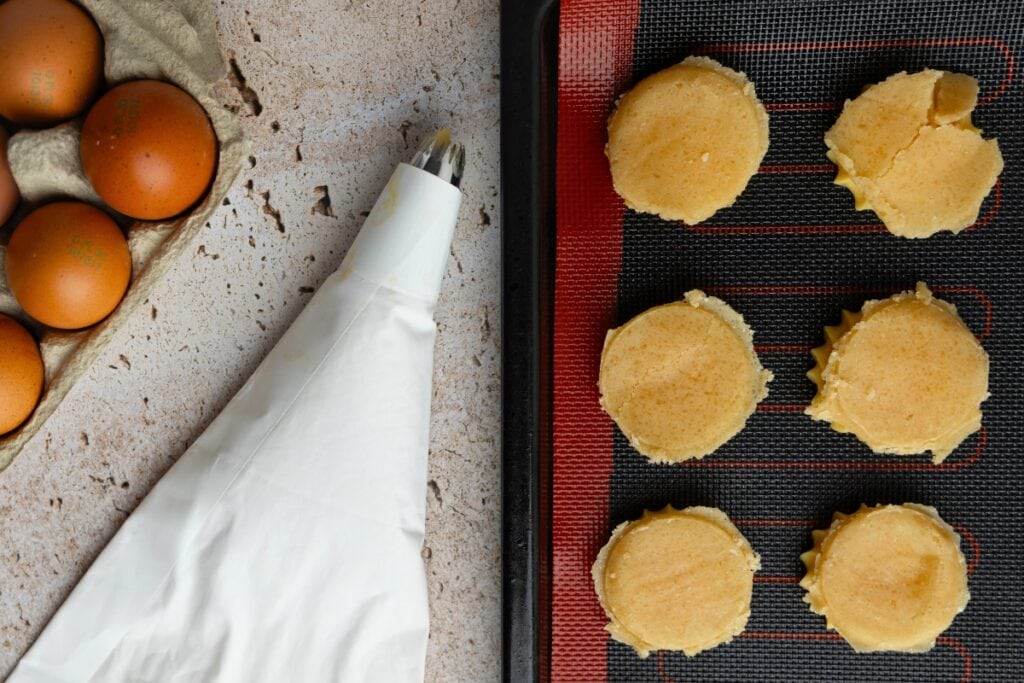
- Bake. Place the tray in the preheated oven, then immediately reduce the temperature to 356°F (180°C). Bake for 40 minutes. Open the door a tiny bit (and leave them open) for the last 5 minutes for any buildup steam to escape. If the puffs start to brown before the 35-minute mark, lower the temperature to 320°F (or 160°C).
- Cool. Remove the puffs from the oven, let them cool for 10 minutes, then carefully detach them from the parchment paper or silicone mat and let them cool on a wire rack for another 10 to 15 minutes.
Step 4: Make Bavarian Cream
(Check out my article on Bavarian cream for more details about the process.)
- Bloom Gelatin: Whisk gelatin with water in a small bowl and let the mixture sit on the counter.
- Boil Milk: Measure the milk into a pot and stir in the vanilla extract. Bring the mixture close to a boil, then take off the heat.
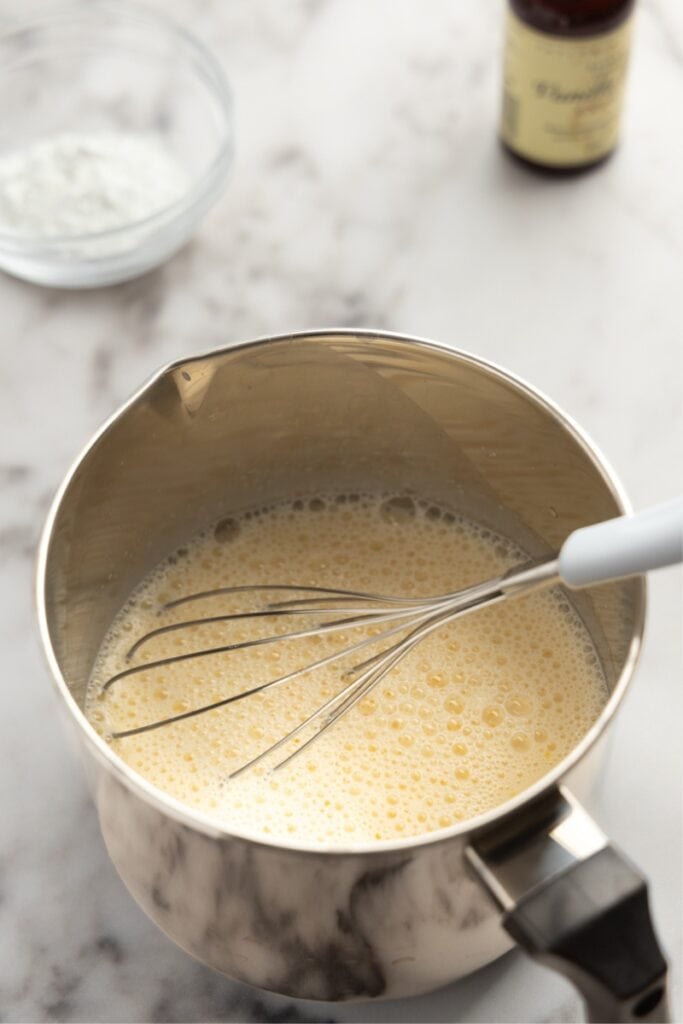
- Prep Yolks: While the milk is heating, whisk the yolks in a large heat-resistant bowl, then stir in the sugar. Set aside.
 Whisk the egg yolks
Whisk the egg yolks Stir in the sugar
Stir in the sugar
- Temper Eggs: Gradually pour a couple of tablespoons of the hot milk into the yolk mixture, constantly whisking to prevent the yolks from curdling. Repeat this process 3 to 4 times until you’ve incorporated most of the milk. Keep stirring throughout.
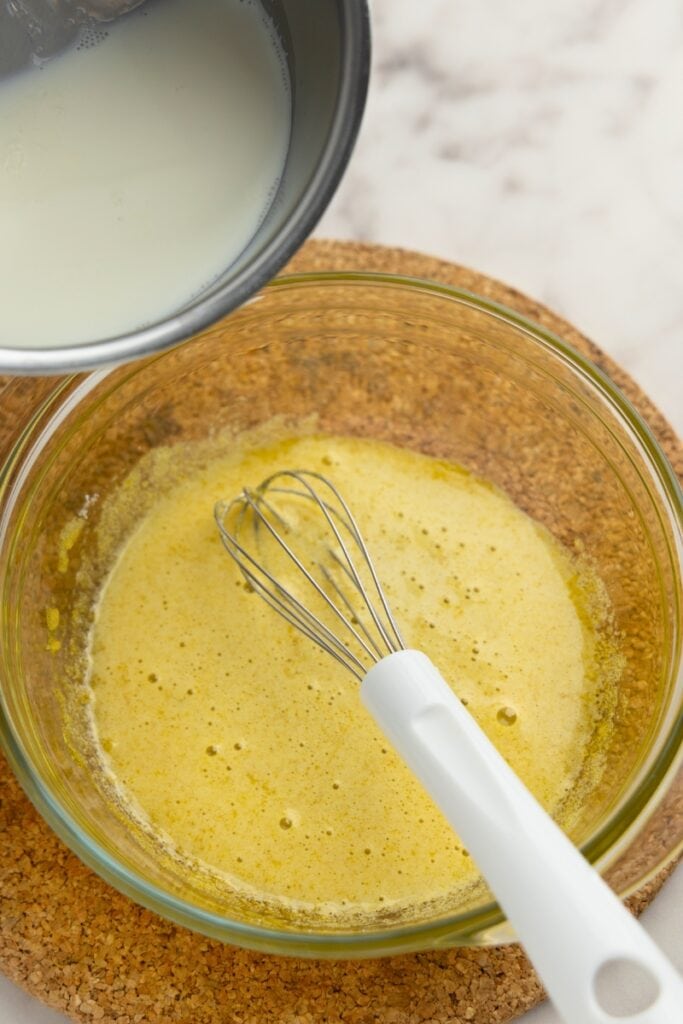
- Cook Until Thick and Bubbly: Return the combined mixture to the pot you used for the milk. Cook it over low heat, stirring constantly, until it thickens and starts to bubble. We go with low heat so that the eggs don’t curdle. The downside is that it sometimes takes quite a while, even more than 5 minutes of stirring. Don’t rush this step.
 Custard should be thick enough
Custard should be thick enough to coat the back of a spoon
to coat the back of a spoon
- Stir for 1 to 2 Minutes: Once the mixture is thick, set it to the lowest possible heat and continue stirring for another 1 to 2 minutes. We want to ensure the yolks go past 160°F (or 71°C) to be perfectly safe for eating. Off the heat after those 1 to 2 minutes.
- Stir in Gelatin: Grab the bowl with the bloomed gelatin and scoop its contents into the creme anglaise. Whisk until the gelatin melts and is incorporated. Set aside until the mixture is warm but not hot anymore: around 105°F or 40°C is perfect.
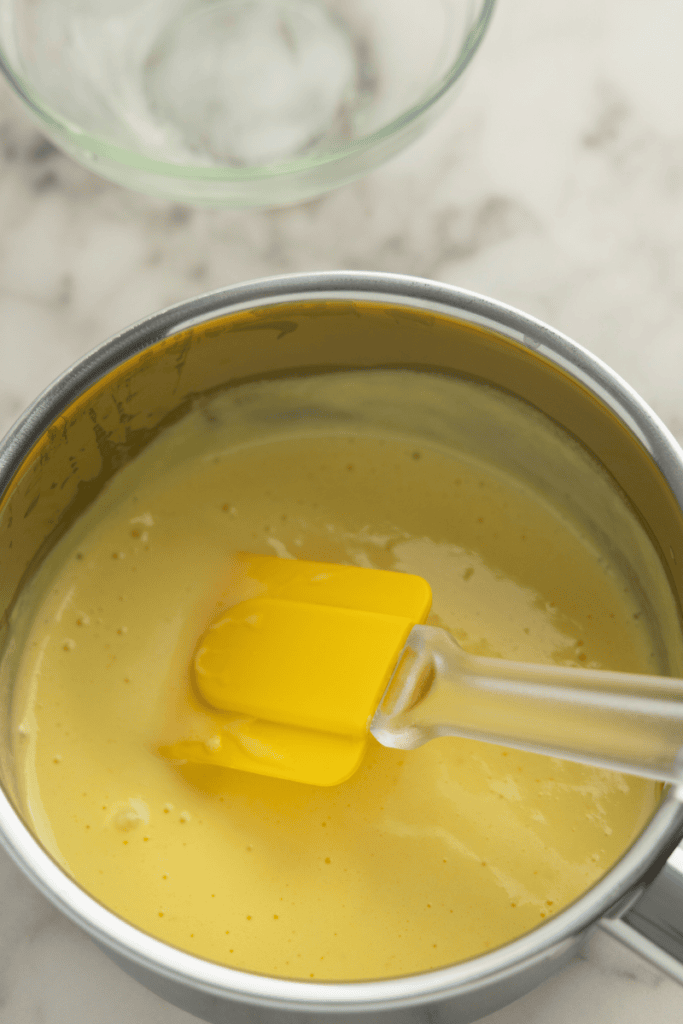
- Whip Heavy Cream: Pour the cold heavy cream into a cold (possibly refrigerated) bowl and whip until medium to firm peaks. Refrigerate until the creme anglaise is ready.

- Strain Creme Anglaise: Pour the warm but not hot creme anglaise into a large bowl through a strainer. That will catch any curdled yolk parts.
 Use a strainer
Use a strainer to catch curdled yolk
to catch curdled yolk
- Fold Whipped Cream: Add about one-third of the whipped cream to the English cream and stir it together. That helps loosen it up before adding the rest. Repeat with the second and third portions of the whipped cream. When folding, be gentle, as you don’t want to deflate the whipped cream or overbeat it. Make sure you scrape the bowl so everything is incorporated, and the color is uniform.
Step 5: Finish Bavarian Cream Puffs
- Pipe Bavarian Cream: Grab a piping bag or a decorating syringe, equip it with a Bismarck tip (the one with a long, thin, and pointed shape) or anything else you use for filling baked goods, and fill the cream puffs with the creme bavaroise.

- Refrigerate for an Hour: The Bavarian cream should set quickly because of the cold whipped cream we stir in, so an hour should be enough for it to set.

- Serve.
Tips
Here are a few tips that might be useful:
- The Spoon Test: Your crème anglaise should coat the back of a spoon. If you drag your finger across the spoon and a clear path stays intact, it’s the right thickness. If it’s too thin, whisk another yolk or two, temper them with your mixture, and continue cooking until the sauce thickens.
 The custard is too thin to coat the back of the spoon nicely. Need more yolks.
The custard is too thin to coat the back of the spoon nicely. Need more yolks. Good thickness – coats the back of the spoon nicely.
Good thickness – coats the back of the spoon nicely.
- Cold Plunge: Need to cool your crème anglaise quickly? Place it in a bowl set over a cold water bath until it reaches the desired temperature. Keep an eye on the temperature to ensure it doesn’t begin to set before you fold in the whipped cream.
- Gently Warm Up If Set: If your crème anglaise has thickened or set, gently warm it over low heat while stirring until it becomes fluid again. Stop heating as soon as it’s liquid; avoid boiling, as that might result in the Bavarian cream not setting properly.
Variations
Explore these modifications to tailor the recipe to your preferences and time constraints.

Flavor Options
While this guide focuses on vanilla Bavarian cream, you’re not limited to one flavor. Consider chocolate, coffee, or other variations to suit your taste. Check out my Bavarian cream article for more ideas.

Simplify
- Skip Crumb Topping: Although the crumb topping adds a nice crunch to the puffs, it’s optional. For a simpler approach, omit it and instead dust the puffs with powdered sugar or drizzle with a quick chocolate ganache, as shown in my vanilla cream puffs recipe. This reduces prep time and still delivers a delightful finish.
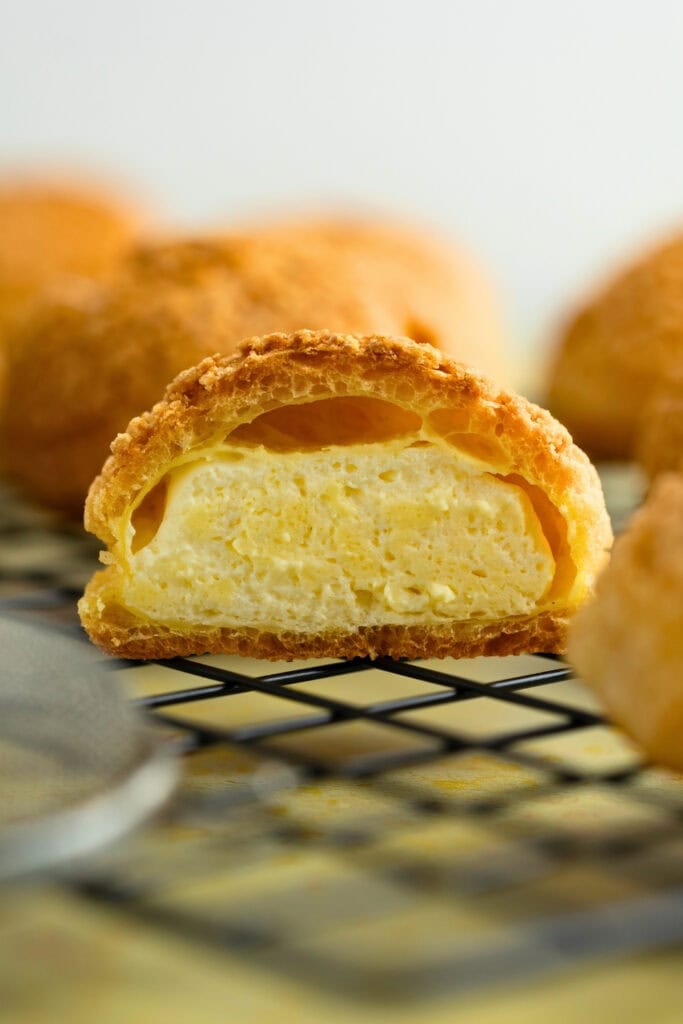
Storage
Bavarian cream puffs should keep for 3 to 4 days in an airtight container in the fridge.
Similar Recipes to Try
Looking for more? Check out the following recipes:
- Cream Puff Fillings. Our list of all cream puff fillings covered on the site. Highly recommended if you’re looking for inspiration.
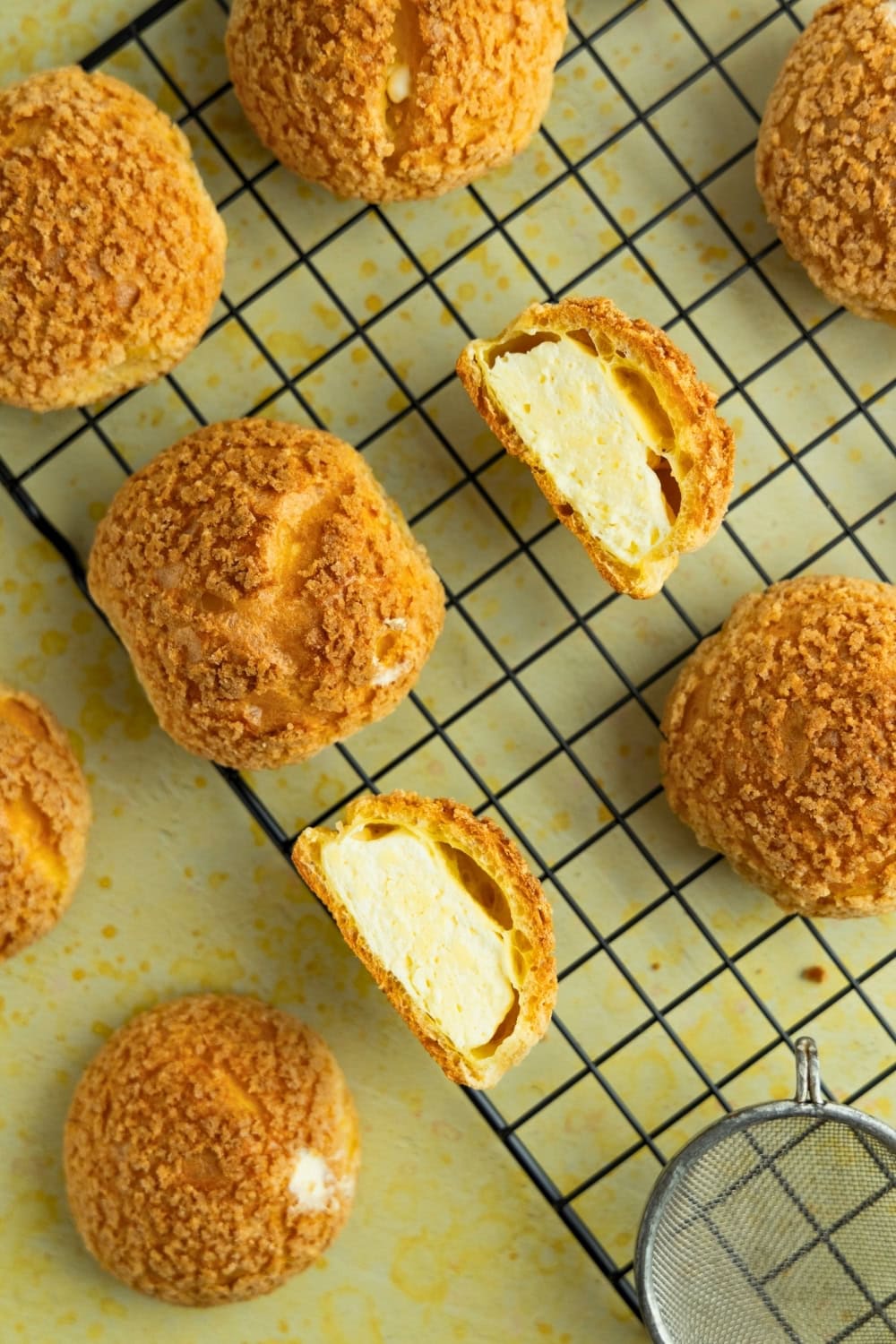
Equipment
Ingredients
Choux Pastry:
- ¼ cup water ~60 ml
- ¼ cup milk ~60 ml
- 3 tbsp unsalted butter ~45 g
- 2½ oz all-purpose flour ~70 g
- ¼ tsp salt
- 1¼ tsp sugar
- 2 large eggs ~95g after cracking
Streusel Topping:
- 2 oz unsalted butter 4 tbsp or 61g
- 2 oz all-purpose flour 1/2 cup or 61g
- 2 oz light brown sugar 1/4 cup or 61g
Bavarian Cream:
- 3/4 cup full fat milk ~180g
- 3 egg yolks medium or large
- 1 1/2 teaspoons vanilla extract
- 4 1/2 tablespoons sugar 56g
- 3 teaspoons gelatin ~9g
- 3 tablespoons water 45g
- 1 1/2 cups heavy cream ~360g
Instructions
Streusel:
- Soften Butter: Cut the butter into cubes and let it soften at room temperature for about an hour.2 oz unsalted butter
- Mix Dry Ingredients: In a medium bowl, combine sugar and flour.2 oz light brown sugar, 2 oz all-purpose flour
- Add Butter: Incorporate the softened butter using a fork or mixer until evenly mixed.
- Roll Out Dough: Between parchment papers, roll dough to a thickness of 2-3mm. Peel and replace paper as needed for easier rolling.
- Refrigerate: Refrigerate the rolled dough (still between sheets) for about 30 minutes, ideally on a cutting board that will retain temperature for longer.
- Cut Shapes: Cut the dough into 2-inch disks quickly before it softens, remove the excess, and return the disks to the fridge.
Choux Pastry:
- Preheat Oven: Heat oven to 390°F (200°C).
- Boil Butter Mixture: In a pot, mix butter, milk, water, salt, and sugar. Bring to a boil, ensuring the butter melts completely.¼ cup water, ¼ cup milk, 3 tbsp unsalted butter, ¼ tsp salt, 1¼ tsp sugar
- Add Flour: Off the heat, add the flour and stir. Return to low heat, stirring continuously for 2-3 minutes until the dough is thick, glossy, and leaves a thin film on the pot bottom.2½ oz all-purpose flour
- Cool Dough: Transfer dough to a bowl and let it cool for 10 minutes, spreading it out to cool faster.
- Whisk Eggs: Beat eggs in a separate bowl.2 large eggs
- Mix Dough: With the dough slightly cooled, mix with a hand mixer. Gradually add half the eggs, mix, then add the remaining eggs bit by bit until the dough forms a 'V' shape when lifted with a whisk or spatula.
Bake:
- Prepare Tray: Line a baking tray with parchment paper or a silicone mat.
- Pipe Dough: Fill a piping bag and pipe dough onto the tray in 2-inch mounds, leaving 1¼ inches space between each.
- Add Streusel: Place refrigerated streusel discs on each dough mound.
- Bake: Place the baking tray in the oven, immediately reduce temperature to 356°F (180°C), and bake for 40 minutes until slightly browned. Open the oven door slightly for the last 5 minutes of baking.
Bavarian Cream:
- Bloom Gelatin: Mix gelatin with water and set aside.3 teaspoons gelatin, 3 tablespoons water
- Heat Milk: Combine milk and vanilla extract; heat until just before boiling.3/4 cup full fat milk, 1 1/2 teaspoons vanilla extract
- Mix Yolks: Whisk yolks and sugar in a separate bowl.3 egg yolks, 4 1/2 tablespoons sugar
- Temper Eggs: Slowly add hot milk to yolks while whisking to prevent curdling.
- Cook Mixture: Return to the pot and simmer on low until thickened, stirring constantly, then cook for an additional 1-2 minutes.
- Add Gelatin: Remove from heat, stir in bloomed gelatin and whisk until smooth. Cool to about 105°F or 40°C.
- Whip Cream: In a chilled bowl, whip the heavy cream to medium or firm peaks. Chill until needed.1 1/2 cups heavy cream
- Strain Anglaise: Strain the creme anglaise into a large bowl to remove any lumps.
- Fold in Cream: Gently fold in whipped cream in thirds to maintain volume. Stir until the mixture is uniform in color.
Finish:
- Fill Puffs: Use a piping bag with a long tip to fill the cooled puffs with Bavarian cream.
- Chill: Refrigerate the filled puffs for at least an hour to set the cream.
- Serve: Enjoy your Bavarian cream puffs after chilling.

